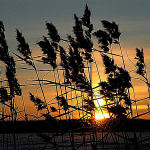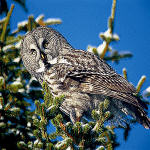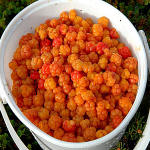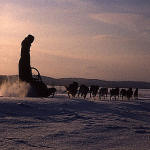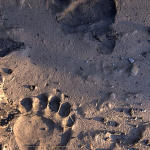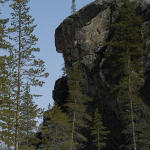

Home
Area
Vätsäri
Övre Pasvik
Pasvik Zapovednik
Nature
Geology
Climate
Water system
Flora
Fauna
Culture
Population
Religion
Sources of livelihood
Old ways of life
Time of industrialism
History
Stone Age
Early Metal Age
Late Metal Age
Middle Ages
Towards modern times
Timeline
Cooperation
Nature monitoring
Nature tourism
Publications
Contacts
Visit Pasvik-Inari
Guidelines
Regulations
News
Links
Øvre Pasvik
Øvre Pasvik National Park
Location: Municipality of Sør Varanger, County of Finnmark, Norway
Area: 119 km²
Establishment: 1970, extended in 2003
Management: A local political board (since 2011); comprising of 2 members from the Sør-Varanger municipality, 1 member from the Finnmark County Council and 1 member form the Sami Parliament.
The largest remaining area of primeval forest in Norway is situated in Øvre Pasvik. The pine forest here is a north-western offshoot of the Siberian taiga. For thousands of years the forest in the National Park has developed without significant human impact. The landscape is flat with low forested hills interspersed with lakes and bogs. The bird life is interesting because eastern species that are rare in Norway and Western Europe are found here. Pasvik is the only area in Norway where brown bears reproduce regularly. The national park is also an important grazing area for a large elk population in winter.
The aim sof the protection of Øvre Pasvik National Park are to to:
- a large, continuous and untouched pine forest,
- conserve a forest ecosystem with a distinctive character and rich biological diversity,
- secure the variation of nature types in the region and to
- conserve sites of cultural heritage.
The area is protected against all activity which may change or disturb the natural environment. Inside the National Park you are not allowed to:
- Destroy or damage plants including dead trees.
- Disturb animals unnecessarily.
- Make fire in the period 15 April - 15 September.
- Use motorized vehicles off road, except for use of snowmobile along public snowmobile tracks.
There is a marked path for hikers in the national park. The path follows the shore of Lake Storbrysttjern and leads to a cabin open for visitors at Lake Ellenvann, and continues to the Norwegian-Finnish border, where there is another cabin open for visitors. Along the path there are information boards that tell about nature and the cultural history of the area.
About 2000 reindeer graze in the national park in winter. The reindeer herders have a cabin in the national park. There are reindeer fences along the borders of Finland and Russia to avoid reindeer from crossing the borders.
Øvre Pasvik Landscape Protection Area
Location: Municipality of Sør Varanger, County of Finnmark, Norway
Area: 54 km²
Establishment: 2003
Management: A local political board (since 2011); comprising of 2 members from the Sør-Varanger municipality, 1 member from the Finnmark County Council and 1 member form the Sami Parliament.
The Øvre Pasvik Landscape Protection Area extends east from the national park towards the Pasvik River. The landscape here is characterized by large and varied bogs and wetlands, with numerous small forest covered islets. The bog areas consist of a mosaic of different bog types. Socalled "palsa", bogs with tussocks with ice cores, are found throughout the area. On the big bogs grow rare and vulnerable species. Pasvik River floats slowly and has large nutritious and shallow areas with rich vegetation. These conditions result in a very rich bird life. The upper parts of the river and the nearby bogs constitute one of the richest areas for waterbirds in Norway. A number of rare and vulnerable species nest in the area.
The aims of the protection of Øvre Pasvik Landscape Protection Area are to:
- conserve a distinctive natural and cultural landscape with a rich biological diversity
- secure the variation of nature types in the region
- conserve landscape formations and distinctive geological formations
The area is protected against any activity that might considerably change or disturb the character of the landscape. Inside the Landscape Protection Area, one is not allowed to:
- Destroy or damage plants including dead trees.
- Disturb animals unnecessarily.
- Make fire in the period 15 April - 15 September.
- Use motorized vehicles off road, except for use of snowmobile along public snowmobile tracks.
There is a marked path for hikers in the Landscape Protection Area. The path goes from Grensefoss to Treriksrøysa ("Three nation's Pile"), the place where the borders of Norway, Russia and Finland meet.
There are several gravel roads in the Landscape Protection Area, in addition to cabins, military buildings and reindeer fences. There are also hydroelectric power plants and dam constructions at Grensefoss and at Hestefoss.
Pasvik Nature Reserve
Location: Municipality of Sør Varanger, County of Finnmark, Norway
Area: 19 km²
Establishment: 1993
Management: Office of the Finnmark County Governor, Department of Environmental Affairs
The Fjærvann (Höyhenjärvi) area is the core of the reserve. This area contains the longest and most intact part of the river's original nature. The water is shallow and has high productivity, rich water and riverside vegetation and a rich bird life. The Fjærvann area is icefree early in the spring and late in the autumn, and has great importance as resting area for a lot of ducks and wading birds that nest in the large bog and forest areas in the Pasvik valley. The bogs are important nesting areas for wading birds. The nature reserve is on the Ramsar list of wetlands of international importance.
The aims of the protection of Pasvik Nature Reserve are to:
- conserve a wetland area that is very important as a nesting and resting area for numerous water bird species
- conserve parts of river Pasvik where the original river bed is intact
- conserve a classical locality with a rich natural and cultural history of great scientific and educational value
The area is protected against all activity which may change or disturb the natural environment.
- All plant life is protected. However, pick berries and mushrooms is allowed,
- Hunting and unnecessary disturbance of birds and animals is not allowed.
- Dogs must be kept on a leash.
- Camping is forbidden without special permission.
- Use of motor vehicles is not permitted outside the roads.
There is a marked path leading to a bird watching tower in the nature reserve. The path begins at Gjøkbukta.
